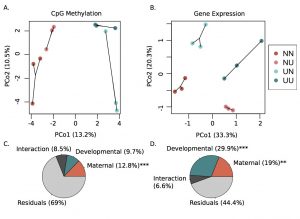Using the purple sea urchin (Strongylocentrotus purpuratus), we have found that the timing of exposure to different environmental conditions influences epigenetic responses: parental conditioning during gametogenesis induces significant changes in DNA methylation of the offspring. However, we observed little connection between changes in DNA methylation to changes in gene expression (Strader et al. 2019, 2020). Following up on this, differential gene expression was modeled as a function of DNA methylation across genomic features and chromatin states (Bogan, Strader and Hofmann, in review). Through this, we found a positive correlation between differential intron methylation and gene expression, an effect that was strongest amongst lowly expressed genes with accessible transcription start sites. Therefore, we have found that changes in epigenetic patterns induced by environmental change likely have multiple, context dependent, functional roles during organismal response to the environment.

To investigate this further, we are examining the role of epigenetic modification on the development of the immune response in S. purpuratus. We are modulating different microbial and temperature environments throughout the life-cycle to link epigenetic changes that occur in response to shifting environments to organismal phenotypes with an emphasis on immune function. The proposed work is designed to answer the following three questions: 1) To what extent is the epigenomic landscape inherited via the germline? 2) How does the environment experienced during embryogenesis shape the epigenome? 3) How does the environment experienced during embryogenesis shape the larval immune response? Utilizing the larval stage of the purple sea urchin, which is an experimentally tractable and ecologically relevant model system gives us an ideal system to address gaps of knowledge connecting the environment, the epigenome and immune phenotypes.
Purple sea urchins are widely distributed across the Pacific coast of the United States and experience highly dynamic environmental fluctuations associated with upwelling. With large population sizes and little population structure across the range, this species is ideal for examining the relative roles of adaptation and phenotypic plasticity in response to differences in abiotic environmental conditions. By generating individual level crosses between purple sea urchins conditioned to variable environments we have teased apart the extent of parental and developmental effects on phenotypic plasticity as well quantified additive genetic variance and evolvability (Strader et al. in review).
